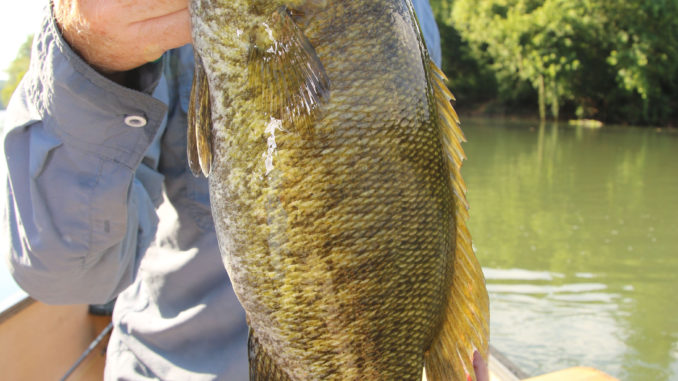
Find cool water,deeper pockets and eddies and do battle with a big bronzeback
The smallmouth bass in the Broad River are in their summertime pattern, and that means anglers can have a field day as long as they concentrate on the coolest water they can find and use three main lures. Rat-L-Traps, in-line spinners like Mepps Black Fury and Aglias, and small, soft-plastics like Zoom’s Ultravibe Speed Craw are all productive lures, especially so when fished in deeper pockets and eddies behind boulders.
“That sound is music to my ears,” said guide Mike McSwain of Broad River Smallmouth when he heard running water just downstream from a large set of shoals that were breaking up the current and causing the water to churn. This churning keeps the water cool and oxygen-rich, producing just the kind of spot smallmouth love to hang out.
Despite the strong current in the Broad, some areas have subsurface grass with long, thick stalks. In these areas, McSwain opts to go with a Speed Craw, rigged Texas-style with a small bullet weight.
“It isn’t possible to fish this lure wrong. Throw it right against the rocks, away from the rocks, fish it fast, fish it slow. You really can do no wrong with this lure,” he said.
In open water, the Rat-l-trap is tough to beat.
“I’ve been catching a lot of smallmouth on the half-ounce Rat-l-Trap, and I like to try different colors. Crawdad patterns seem to work well, and this lure is more versatile than people think. You can cast it tight to rocks and in the middle of strong, boiling current. And when you’re between shoals in what appears to be flat, calm water, this lure can produce when nothing else will,” said McSwain.
The Mepps spinners are good all over the river. Even where weeds are present, they’re are effective as long as you reel them fast enough to keep them above the weeds. They are especially good in strong current. Casting them above a set of rocks and allowing them to tumble through the rocks in the current, then reeling in once they make it through is a good tactic. Another good area to use them is where strong current meets slack water behind rocks. Smallmouth will hit these lures in any part of the retrieve through these sections.
The Broad’s depth changes depending on how much water is being released from the handful of dams that feed it, but McSwain said this time of year, the depth is usually more favorable to anglers in the afternoon and deep into the evening.
“They release water throughout the night, so the water is typically high in the morning and drops to a really good, fishable level by the afternoon,” he said.


Be the first to comment